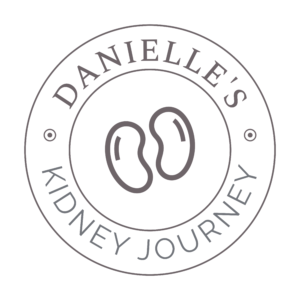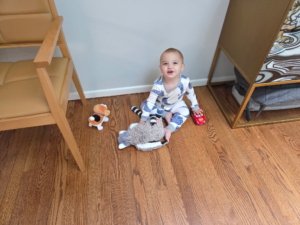Moments of ‘Happily’
Hi Everyone,
Some good news on my end: for three mornings in a row, I’ve been feeling better. On Monday, I woke up with energy, went for a 40-minute hike with my mom, and even ran errands. By the end of the day, I was tired and needed to rest, but it felt like a big improvement. Yesterday, I woke up with a bit of energy too. Even though I had IVIG treatments (which ultimately exhausted me), I noticed a new kind of vigor in the morning that I haven’t felt in a while. And this morning, I woke up early and actually had the energy and desire to write this email. I’ll take what I can get.
I don’t know if this means the treatments are working—my labs from yesterday are holding steady, not improving—but it can take several weeks to months for results to change.
I was also able to get an appointment with a hematologist at Georgetown who specializes in aHUS next week, and a nephrologist at Hopkins at the end of the month. Thank you all for working your magic and making the connections.
If this diagnosis is correct, I’m learning it likely means I’ll live with this disease for the rest of my life, since there’s no cure right now. aHUS may involve attacks or flares, and because it impacts multiple organs—it’s essential to have a team of specialists guiding my care. I joined an online support group, and while this disease is incredibly challenging, I’m learning that people live with it for decades.
Interestingly, my neurologist told me yesterday that the drug I’m on—Ultomiris—is considered cutting edge in a lot of medical circles and was only approved by the FDA six years ago. I feel incredibly lucky my insurance covered it. I can’t help but think: if this disease had been silently in me all along, it might have killed me if I had had Barney in my early 30s. It seems pregnancy and delivery may have initially triggered it.
In other news, I’ve been working with Brad on an article for Bethesda Magazine about our experience with living donation. I feel honored they took an interest in our story. I originally reached out when I was seeking a donor, and after my transplant, they wanted to feature it—when everything looked bright and uncomplicated.
But shortly after the reporter contacted me, I was hospitalized with a virus that led to severe kidney rejection and complications. I believed things would turn around quickly, so I agreed to the interview—not realizing how long the setbacks would last. It made me think: the complex transplant stories often go untold, yet they’re the ones that also show why living donation matters—not just when it goes smoothly.
I wanted to be the “voice of successful living donation” because I believe so deeply in how much it changes lives—and I still do. But it’s hard when my story doesn’t look like the neat, happy outcome people often expect.
Still, living donation has changed my life profoundly. My mind is clearer, I can eat more freely, and even though I’ve been sick these past two months, I have more energy than I did on dialysis—especially now that treatments are tapering and I’m managing the side effects better. Most of all, I’m no longer tethered to a dialysis machine for hours a day.
These aren’t the stories we usually hear—of rare disease, of rejection, of uncertainty. They don’t fit the fairy tale of an altruistic donor saving a life with a flawless ending. But they’re real. Severe rejection—where kidney function drops significantly or hospitalization is required—is rare, affecting only 1–5% of patients. So I know I’m in the minority. But with timely, aggressive treatment like I’ve had, many kidneys recover at least partial function. I still believe that’s going to be my story.
Lately I’ve been thinking about why we cling to fairy tale endings and “happily ever after.” In my experience, idealism and dreaming are ways people try to cope with how hard life can be. Our minds are wired for fight, flight, freeze, or fawn—innate responses meant to keep us alive. Many people meditate, go to therapy, pursue religion, take medication—anything to soothe that wiring. And often, it helps. But still, life is messy. Sometimes we reach for the fairy tale because imagining a happier ending feels easier than sitting with what I believe to be true: life is far more complicated, and our brains are simply built to seek safety.
When I raised my concern with the reporter that I didn’t have a happily ever after right now, she compassionately said, “People also like real stories.” I replied, “I do have a lot of ‘happily’ moments (I know this word is typically used as an adverb).”
For me, this is so true.
Back in October 2024, 95 people signed up to get tested when I launched my campaign. Brad—someone I had never met—became my donor and now my dear friend. So many people have supported me with kind words, meals, cards, and gestures that have made this journey more bearable. These have been ‘happily’ moments.
Before all of this, I once asked Brad, “What if my kidney fails?” And he said, “It would still be worth it—for the chance to give you a second chance.” That meant everything to me, a true ‘happily’ moment.
I also think about the three other people whose lives were changed because of my campaign—people who received donors because others were inspired to step up. Just last week, another friend told me she’s donating a kidney in November, and it brought me to tears. These are truly ‘happily’ moments.
This week reminded me that maybe life isn’t about a singular happily ending. Maybe it’s about the moments—all my connections who helped connect me with Georgetown and Hopkins, the four handwritten cards in my mailbox, the calls and texts filled with love.
It takes a village to get through this—and I’m so lucky to have that village, which includes you. Even if my health isn’t where I want it to be, you all keep showing up. Your generosity humbles me.
And those three mornings I woke up feeling better, like this morning hanging out with Barney… I’ll take them. They are moments of ‘happily.’
Wishing you moments of ‘happily’ as well.
Love,
Danielle
PS. I’ve attached a cute picture of Barney with this post.
Interested in becoming a living kidney donor? Learn more through DOVE, a nonprofit supporting veterans in need.



